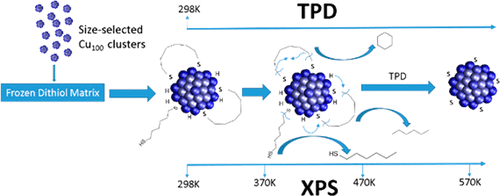当前位置:
X-MOL 学术
›
J. Phys. Chem. C
›
论文详情
Our official English website, www.x-mol.net, welcomes your feedback! (Note: you will need to create a separate account there.)
Combined TPD and XPS Study of Ligation and Decomposition of 1,6-Hexanedithiol on Size-Selected Copper Clusters Supported on HOPG
The Journal of Physical Chemistry C ( IF 3.7 ) Pub Date : 2018-01-18 00:00:00 , DOI: 10.1021/acs.jpcc.7b10452 Linjie Wang 1 , Nicolas Blando 1 , Zachary Hicks 1 , Michael Denchy 1 , Xin Tang 1 , Hannes Bleuel 2 , Mingshi Zhang 1 , Gerd Ganteför 2 , Kit H. Bowen 1
The Journal of Physical Chemistry C ( IF 3.7 ) Pub Date : 2018-01-18 00:00:00 , DOI: 10.1021/acs.jpcc.7b10452 Linjie Wang 1 , Nicolas Blando 1 , Zachary Hicks 1 , Michael Denchy 1 , Xin Tang 1 , Hannes Bleuel 2 , Mingshi Zhang 1 , Gerd Ganteför 2 , Kit H. Bowen 1
Affiliation

|
Ligation and decomposition of 1,6-hexanedithiol on copper clusters have been studied by means of temperature-programmed desorption (TPD) and X-ray photoelectron spectroscopy (XPS). Copper cluster anions were first made via magnetron sputtering, then size selected and soft landed into a frozen matrix of 1,6-hexandithiol on highly ordered pyrolytic graphite (HOPG) maintained at 100 K. After warming up to 298 K, a combination of TPD and XPS were performed to characterize the newly deposited sample. TPD data shed light upon the adsorption and decomposition pathways of 1,6-hexanedithiol molecules on copper clusters. Based on the TPD data, two different binding motifs are proposed: the dangling motif is with one sulfur atom binding to a copper cluster, and the bidentate motif is with both sulfur atoms binding to a copper cluster. Different decomposition products were observed for each binding motif. A series of hydrogen atom titration experiments were designed to provide further evidence for the proposed decomposition mechanism. XPS measurements at varied temperatures agree well with the TPD profile by confirming the formation of dithiol ligated copper clusters through Cu–S bond formation, and the decomposition of them via C–S bond scission. How well the dithiol ligand can protect the copper clusters from being oxidized is discussed, and the ligand number per cluster is estimated.
中文翻译:

TPD和XPS联合研究HOPG支撑的1,6-己二硫醇在大小选择的铜簇上的连接和分解
已通过程序升温脱附(TPD)和X射线光电子能谱(XPS)研究了1,6-己二硫醇在铜簇上的连接和分解。首先通过磁控溅射制备铜簇阴离子,然后选择大小,然后在保持在100 K的高度有序的热解石墨(HOPG)上软着陆到1,6-己二硫醇的冷冻基质中。预热到298 K后,将TPD组合用XPS和XPS表征新沉积的样品。TPD数据揭示了1,6-己二硫醇分子在铜簇上的吸附和分解途径。基于TPD数据,提出了两种不同的结合基序:悬空基序具有一个硫原子与铜簇结合,而双齿基序具有两个硫原子与铜簇结合。对于每个结合基序观察到不同的分解产物。设计了一系列氢原子滴定实验,为拟议的分解机理提供了进一步的证据。通过确定Cu-S键形成二硫醇连接的铜簇以及通过C-S键断裂将其分解,在不同温度下进行XPS测量与TPD曲线非常吻合。讨论了二硫醇配体如何保护铜簇免受氧化,并估算了每簇的配体数。通过确定Cu-S键形成二硫醇连接的铜簇以及通过C-S键断裂将其分解,在不同温度下进行XPS测量与TPD曲线非常吻合。讨论了二硫醇配体如何保护铜簇免受氧化,并估算了每簇的配体数。通过确定Cu-S键形成二硫醇连接的铜簇以及通过C-S键断裂将其分解,在不同温度下进行XPS测量与TPD曲线非常吻合。讨论了二硫醇配体如何保护铜簇免受氧化,并估算了每簇的配体数。
更新日期:2018-01-18
中文翻译:

TPD和XPS联合研究HOPG支撑的1,6-己二硫醇在大小选择的铜簇上的连接和分解
已通过程序升温脱附(TPD)和X射线光电子能谱(XPS)研究了1,6-己二硫醇在铜簇上的连接和分解。首先通过磁控溅射制备铜簇阴离子,然后选择大小,然后在保持在100 K的高度有序的热解石墨(HOPG)上软着陆到1,6-己二硫醇的冷冻基质中。预热到298 K后,将TPD组合用XPS和XPS表征新沉积的样品。TPD数据揭示了1,6-己二硫醇分子在铜簇上的吸附和分解途径。基于TPD数据,提出了两种不同的结合基序:悬空基序具有一个硫原子与铜簇结合,而双齿基序具有两个硫原子与铜簇结合。对于每个结合基序观察到不同的分解产物。设计了一系列氢原子滴定实验,为拟议的分解机理提供了进一步的证据。通过确定Cu-S键形成二硫醇连接的铜簇以及通过C-S键断裂将其分解,在不同温度下进行XPS测量与TPD曲线非常吻合。讨论了二硫醇配体如何保护铜簇免受氧化,并估算了每簇的配体数。通过确定Cu-S键形成二硫醇连接的铜簇以及通过C-S键断裂将其分解,在不同温度下进行XPS测量与TPD曲线非常吻合。讨论了二硫醇配体如何保护铜簇免受氧化,并估算了每簇的配体数。通过确定Cu-S键形成二硫醇连接的铜簇以及通过C-S键断裂将其分解,在不同温度下进行XPS测量与TPD曲线非常吻合。讨论了二硫醇配体如何保护铜簇免受氧化,并估算了每簇的配体数。

























 京公网安备 11010802027423号
京公网安备 11010802027423号